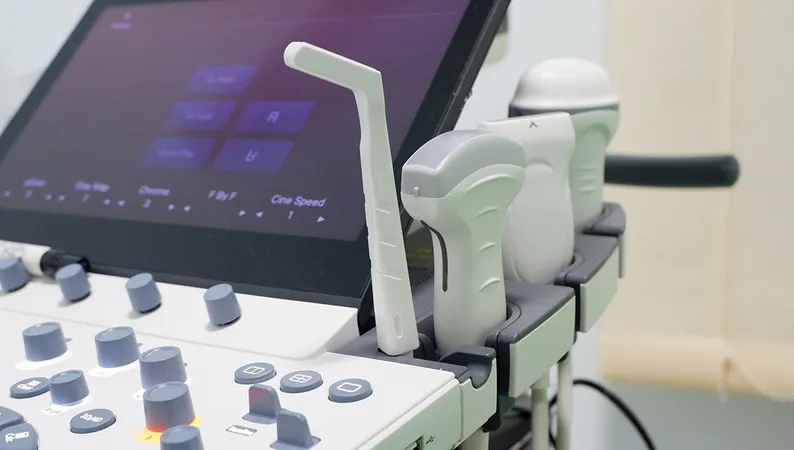
Revolutionary SONOBIRDIE Study Revolutionizes Carotid Endarterectomy with Ultrasound!
2025-03-25
Author: Li
Introduction
Recent findings from the groundbreaking SONOBIRDIE trial have revealed that the use of ultrasound during carotid endarterectomy significantly enhances patient safety, reducing the risk of severe neurological complications within the first 30 days of surgery. Conducted among 1,004 participants, both symptomatic and asymptomatic, this study marks a pivotal step in improving surgical outcomes for those suffering from carotid stenosis.
Study Results
The trial, headed by Dr. David Školoudík at the University of Ostrava in Czechia, showed an astonishing 5.5% decrease in the combined rate of ischemic strokes, transient ischemic attacks (TIAs), or death among patients treated with ultrasound-assisted procedures compared to those receiving a sham intervention (P < 0.001). The early results indicated that using ultrasound, a technique known as sonolysis, effectively breaks up thrombus and leads to more favorable outcomes.
Imaging Substudy Findings
A fascinating imaging substudy further revealed that patients receiving ultrasound were significantly less likely to develop new ischemic lesions visible on brain MRI conducted just 24 hours post-surgery, with rates dropping from 17.4% in the sham group to just 8.5% in those treated with sonolysis (P = 0.004). This points to the potential for ultrasound not only to enhance the surgical procedure but also to improve long-term brain health for patients undergoing these interventions.
Cautions and Concerns
While these results are promising, Dr. Školoudík cautions that the full impact of sonolysis requires further investigation before it can be adopted as a standard practice in clinical guidelines. Dr. Jesse Columbo, associated with Dartmouth Health, raised valid concerns regarding the study's control group, which exhibited a surprisingly high rate of adverse outcomes, prompting a call for additional trials that better reflect the diverse populations treated in everyday clinical practice.
Technological Advancements in Surgery
The SONOBIRDIE trial not only builds on earlier evidence suggesting ultrasound can facilitate thrombus dissolution through various mechanisms—whether through physical disruption or stimulation of the body’s natural clot-dissolving processes—but also emphasizes the extensive capabilities of ultrasound technology in a surgical environment. Traditional uses of ultrasound have revolved mainly around diagnostics; however, this trial could pave the way for its revolutionary application in high-stakes surgical scenarios.
Trial Design and Results
As part of the trial conducted across 16 medical centers in Czechia, Slovakia, and Austria, participants were randomized to receive either ultrasound assistance or a placebo procedure during their carotid endarterectomy. Remarkably, the ultrasound treatment group witnessed an ischemic stroke or TIA rate of only 2.2%, compared to 7.6% in the sham intervention group (risk ratio 0.28; 95% CI 0.15-0.54). No significant mortality difference was observed at 30 days or one year between the two groups.
Safety and Adverse Events
Importantly, the procedure's safety was upheld, with a staggering 94.4% of patients in the ultrasound group reporting no serious adverse events in the critical 30-day window following surgery. Only one participant, who received the sonolysis treatment, experienced intracerebral bleeding.
Future Implications
Despite these encouraging insights, Dr. Columbo urged caution, highlighting the need for further studies to explore the clinical effectiveness of ultrasound in varied populations and to establish comprehensive guidelines for clinical application. However, he noted that if concerns regarding the study’s internal validity can be addressed, the low-risk profile of ultrasound combined with its potential benefits presents a compelling case for its use during carotid endarterectomy procedures.
Conclusion
In conclusion, the SONOBIRDIE trial’s findings have opened new avenues in surgical techniques, showcasing how integrating simple technologies like ultrasound could drastically improve patient outcomes in vascular surgeries. As the medical field continues to evolve, the promise of ultrasound-assisted procedures could very well reshape the future of surgical care.




 Brasil (PT)
Brasil (PT)
 Canada (EN)
Canada (EN)
 Chile (ES)
Chile (ES)
 Česko (CS)
Česko (CS)
 대한민국 (KO)
대한민국 (KO)
 España (ES)
España (ES)
 France (FR)
France (FR)
 Hong Kong (EN)
Hong Kong (EN)
 Italia (IT)
Italia (IT)
 日本 (JA)
日本 (JA)
 Magyarország (HU)
Magyarország (HU)
 Norge (NO)
Norge (NO)
 Polska (PL)
Polska (PL)
 Schweiz (DE)
Schweiz (DE)
 Singapore (EN)
Singapore (EN)
 Sverige (SV)
Sverige (SV)
 Suomi (FI)
Suomi (FI)
 Türkiye (TR)
Türkiye (TR)
 الإمارات العربية المتحدة (AR)
الإمارات العربية المتحدة (AR)